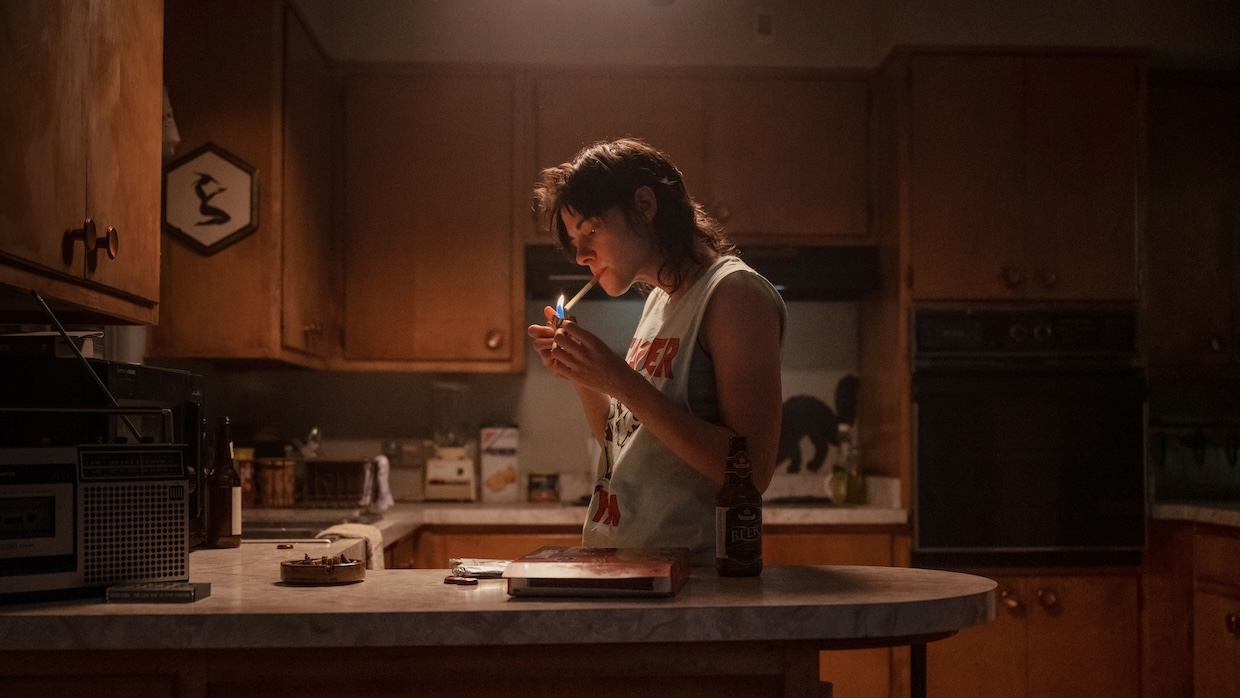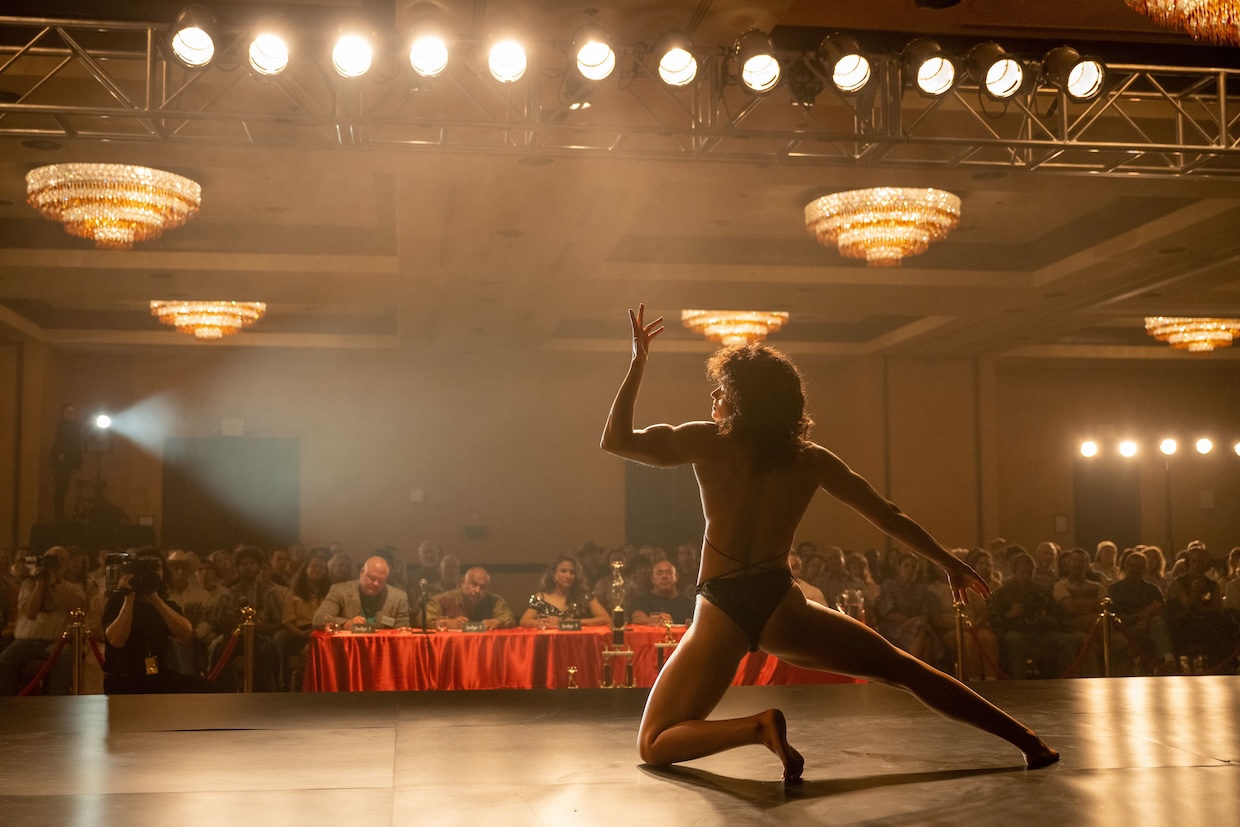 Back to selection
Back to selection
Shutter Angles
Conversations with DPs, directors and below-the-line crew by Matt Mulcahey
“I’m Not Into Embracing the Digital Look”: DP Ben Fordesman on Love Lies Bleeding
 Kristen Stewart in Love Lies Bleeding
Kristen Stewart in Love Lies Bleeding After setting her directorial debut Saint Maud in a fading English seaside town, London-born filmmaker Rose Glass turns her gaze toward the American southwest for the neo-noir follow-up Love Lies Bleeding.
Set in 1989 and shot in New Mexico by Maud cinematographer Ben Fordesman, the film follows the violent repercussions when a nomadic bodybuilder (Katy O’Brian) falls for a small-town gym manager (Kristen Stewart) with a family full of criminals (including gun-running dad Ed Harris).
With the A24 movie out today on VOD, Blu-ray and UHD following its theatrical run, Fordesman spoke to Filmmaker about emulating film on digital, pick-ups as the final pieces to a puzzle and the best way to roll a corpse wrapped in carpet down a metal staircase.
Filmmaker: The seaside town in Saint Maud was a pivotal piece of the vibe of that film. The isolated desert town is equally important to Love Lies Bleeding. I read an interview where Rose Glass said she had barely been to America when she decided to set the film there. Had you spent much time in the States before this shoot?
Fordesman: I had worked in the States a fair amount myself, but we are all students of cinema growing up on American movies. I’m thinking about Wim Wenders [as a foreign director capturing American] in Paris, Texas. He did a pretty good job. (laughs)
Filmmaker: I don’t know how much shot listing or visual prep you’d done with Rose before the locations were locked in. Did your plans for the look change much once you got to New Mexico and saw the locations and landscapes?
Fordesman: A lot of precise planning went into how we shot this movie. Luckily, I was able to attend the director’s scout of New Mexico in the Albuquerque area months in advance of official preproduction. So, we were able to design the shots per scene with some idea of what we were dealing with. Many sequences were shot as we had discussed, and some changed in a moment’s notice after reviewing a rehearsal from our actors. Storyboards were used for some of the bigger set pieces, which are a huge benefit for the whole crew to understand our process.
Filmmaker: For the second straight movie with Rose, you were foiled in your hopes of shooting on film. On Saint Maud, you wanted to shoot 16mm. For Love Lies Bleeding, you wanted to shoot on 35mm. For both of those projects, was film seriously considered or was that a dream that was dashed pretty early in the process?
Fordesman: Yeah, we love celluloid, particularly for a film set in the 1980s, and for many it feels like the only format, right up until the point when you’re told otherwise. We tried our best, but budget wasn’t in our favor.
Filmmaker: How did you try to approximate that film look?
Fordesman: Whenever I shoot digital, I’m constantly thinking about how to make it look like film, which really asks the question, “Why didn’t you just shoot on film?” I’m not into embracing the digital look. It’s no secret that people like to shoot on higher ISOs to add some digital noise. For the regular Alexa Mini [which Love Lies Bleeding was shot on] that would mean 1280 or 1600 ISO, but to be honest lately I’ve just been relying mostly on adding this in the grade. I shot with the Panavision PVintage Primes, Super Speeds and Ultra Speeds, some of my favorite lenses out there. I think their filmic look can really come together in the grade. Vanessa Taylor, our colorist, and I spent a long time adjusting saturation in shadows, emulating how film reacts to skin tones, halation in highlights or high contrast situations, but there is only so far you can go, plus you have a limited amount of time.
Filmmaker: For me, the most iconic shot in Saint Maude is the titular character levitating in her apartment. I watched a behind the scenes doc about the film and saw that it was a pretty simple solution to get that shot—you put the actress on a forklift-like machine intended to help lift heavy objects onto shelving and then simply painted the machine out in post. Is there something from Love Lies Bleeding that was similar? A deceptively simple solution for a seemingly complex problem?
Fordesman: Nothing springs to mind, but we did have a little debate on how best to throw a corpse wrapped in carpet down Lou’s metal staircase. Rose won with the dummy body rolled in the carpet, which glided down beautifully. I had an elaborate back up plan with ropes and pulleys, which we didn’t need.
Filmmaker: Tell me about the opening shot of the film, where the camera comes out of this red crevice in the desert, booms down and tracks into Lou’s gym. Saint Maud had such a restrained style that was perfect for that film, but this shot to kick off Love Lies Bleeding let me know immediately that you were going for something different. How was that executed? I’m assuming it’s some sort of stitch between that crevice shot and the shot of the practical gym location. Is there another stitch when the camera finishes that boom down and moves toward the gym, or is that something practical like a Steadicam operator stepping off a crane?
Fordesman: Yeah, exactly. It’s a Steadicam operator standing on a small platform on top of a Giraffe crane at full height. They are lowered to the ground and step off gently, which develops into a regular Steadicam walking shot. That method sounds extremely elaborate, but it’s been around for a while. I guess more people are doing the gimbal crane takeover technique now. The opening shot from the crack in the earth and tilt down from the sky were all VFX up until you see the land.
Filmmaker: I read that the desert chasm was almost entirely a visual effect. Is that true?
Fordesman: It’s half VFX. We couldn’t find a perfect crack-in-the-earth location. We shot in a gypsum mine and later VFX helped build in the shear walls.

Filmmaker: Walk me through your lighting approach to the gym.
Fordesman: The gym was tricky. We needed to, at times, light the entire space for our wide shots, particularly the opening Steadicam shot. It made total sense to light with fluorescent fittings, which looked great seeing them in shot, but any time we moved into a mid or close-up you had dozens of individual lights to contend with, so we were constantly turning lights on or off, adding diffusion or flags to help create shape, or sometimes turning them all off altogether and replacing the lighting with film lights for close-ups.
Filmmaker: I was surprised to learn when I listened to the Saint Maud commentary track that several of the key scenes—including the opening one and the entire thread of the cockroach as a physical manifestation of Maud’s delusions—were pick-ups done once Rose was in the middle of editing the film. The red-tinged inserts in Love Lies Bleeding that show Ed Harris’ character disposing of people in the desert crevice followed that same trajectory and were added via pick-ups once Rose was editing the film.
Fordesman: I actually really enjoy pick-ups. It’s like adding final pieces to a puzzle. We shot all our pick-ups in the big gym location in Albuquerque, with small corners of sets here and there. The red light was something Rose was keen on. It’s my favorite color on film to work with, so I wasn’t going to question it. That said, getting the right quality of red on digital is really, really tricky and we spent a lot of time adjusting luminosity, saturation and hue in the grade.
Filmmaker: There are so many great inserts in the film. I see an Insert Unit listed in the credits.
Fordesman: There was a 2nd unit, which came on fairly last minute, headed by DP/director Peter Collister. They produced some valuable shots during the main shoot for us with such little time and prep. I think the insert unit may have been from a little extra pick-up day we shot in London. That was extreme close-up stuff, like a coin going in payphone and wiping blood from picture frames.

Filmmaker: Walk me through how you lit O’Brian’s body building competition in Vegas.
Fordesman: That location was great for its chandeliers. Each was controllable individually and on separate dimmers, an absolute dream for gaffer Jon McGinty and I. The rest [of our lighting] was built into the stage truss—lots of Par cans, a big Juliat 2.5K HMI follow spot and lots of smoke. We had a couple of moving lights in there too, which added a bit of dynamic movement to the lighting for the in-between scenes, which I guess may have been slightly too modern for this time, but it felt like we could get away with it.
*Spoiler Alert*
Filmmaker: I read that you did that fantastical scene of Stewart and O’Brian euphorically running through the clouds on the tennis court at Harris’s house location.
Fordesman: Yes! It wasn’t ideal, but in the end it was totally fine. We only had a short distance to get up to full speed, then everyone had to jam on the brakes. We had the perfect natural sunset with dreamy light. I was being pulled on a rickshaw and operated handheld with a 14mm lens at 200fps. VFX added a washing line with markers behind Katy and Kristen, so they had something to track to add the clouds after. It was a fun shot in the end.
Filmmaker: The final shot is one of my favorites in the film. I don’t want to give away too many of the details of what specifically happens, but let’s just say it involves a pick-up truck on the side of the road and a long take in which the camera pushes into the truck cab.
Fordesman: Yeah, that is one of my favorite shots in the film as well, and it came together quite late. There was a different ending written in the script, but we had to change the idea fairly last minute due to the locations we were restricted to. I can’t remember whose idea it was to push into the window like that, but since Rose isn’t sitting here I will take full credit for now. (laughs) It’s coming back to me that we had to shoot this scene backwards, since it’s meant to be morning and the sun would gradually be rising, but we could only shoot this scene in the evening, with the dying light. That was just how our shooting schedule demanded it. So, thankfully, Kristen and Katy were really onboard with shooting the scene [chronologically] backwards in terms of performance.
Filmmaker: What is the story behind the end credits shot of Katy and Kristen dancing against the red background? Was that just something you shot when the actors were messing around that ended up in the movie or was that planned with a specific purpose in mind?
Fordesman: Yes, that was planned for the end credit sequence. I think the color was an afterthought. We all love red, right? But we shot that in a way in which any color could be added afterward.
